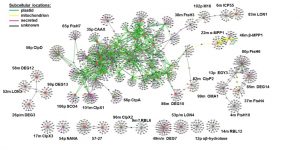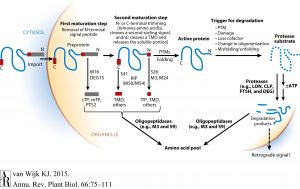Chloroplast protein homeostasis (proteostasis) through coordinated action of proteolytic systems in chloroplasts.Chloroplasts contains several thousand different proteins, some with a high number of copies (e.g. Rubisco) and other with very low copy number. Some proteins have a very short half-life of just ~30 min, whereas others are stable for several days. Chloroplasts contain many different protease systems encoded by ~100 genes. Research in the van Wijk lab aims to determine what controls the stability of chloroplast proteins. We are particularly interested to determine the signals/information within proteins that are recognized by different proteases; such signals are called degrons and hold the key to understanding proteolysis. We are study the coordination of protease activity with the metabolic state of chloroplasts, and integration of different protease activities (i.e. protease networks). We mainly use Arabidopsis, but also maize, as our experimental system and we generated many single and higher order chloroplast protease mutants to study genetic and functional interactions within the protease network. A variety of proteomics and mass spectrometry techniques (e.g. TAILS) are used to track, identify and quantify N-terminal maturation, proteolytic cleavage events and accumulation of protein degradation products. In planta substrate trapping and affinity enrichment further help to identify substrates and discover protein-protein interactions, e.g. resulting recently in our discovery of a new adaptor ClpF. This research is funded by the National Science Foundation (NSF).




